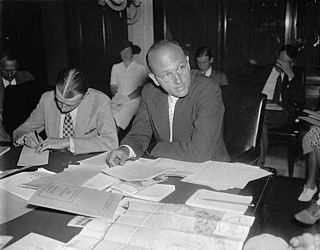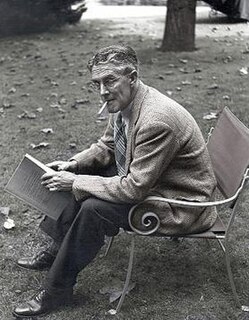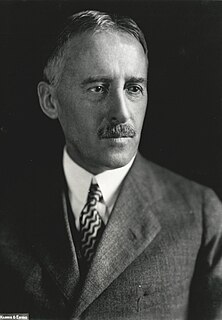Related Research Articles

The United States Atomic Energy Commission, commonly known as the AEC, was an agency of the United States government established after World War II by U.S. Congress to foster and control the peacetime development of atomic science and technology. President Harry S. Truman signed the McMahon/Atomic Energy Act on August 1, 1946, transferring the control of atomic energy from military to civilian hands, effective on January 1, 1947. This shift gave the members of the AEC complete control of the plants, laboratories, equipment, and personnel assembled during the war to produce the atomic bomb.

Gordon Evans Dean was a Seattle-born American lawyer and prosecutor who served as chairman of the United States Atomic Energy Commission (AEC) from 1950 to 1953.

Lewis Lichtenstein Strauss was an American businessman, philanthropist, and naval officer who served two terms on the U.S. Atomic Energy Commission (AEC), the second as its chairman. He was a major figure in the development of nuclear weapons, the nuclear energy policy of the United States, and nuclear power in the United States.

David Eli Lilienthal was an American attorney and public administrator, best known for his Presidential Appointment to head Tennessee Valley Authority and later the Atomic Energy Commission (AEC). He had practiced public utility law and led the Wisconsin Public Utilities Commission.

Brien McMahon, born James O'Brien McMahon was an American lawyer and politician who served in the United States Senate from 1945 to 1952. McMahon was a major figure in the establishment of the Atomic Energy Commission, through his authorship of the Atomic Energy Act of 1946.

Henry DeWolf "Harry" Smyth was an American physicist, diplomat, and bureaucrat. He played a number of key roles in the early development of nuclear energy, as a participant in the Manhattan Project, a member of the U.S. Atomic Energy Commission (AEC), and U.S. ambassador to the International Atomic Energy Agency (IAEA).

The Interim Committee was a secret high-level group created in May 1945 by United States Secretary of War, Henry L. Stimson at the urging of leaders of the Manhattan Project and with the approval of President Harry S. Truman to advise on matters pertaining to nuclear energy. Composed of prominent political, scientific and industrial figures, the Interim Committee had broad terms of reference which included advising the President on wartime controls and the release of information, and making recommendations on post-war controls and policies related to nuclear energy, including legislation. Its first duty was to advise on the manner in which nuclear weapons should be employed against Japan. Later, it advised on legislation for the control and regulation of nuclear energy. It was named "Interim" in anticipation of a permanent body that would later replace it after the war, where the development of nuclear technology would be placed firmly under civilian control. The Atomic Energy Commission was enacted in 1946 to serve this function.

The 90th United States Congress was a meeting of the legislative branch of the United States federal government, composed of the United States Senate and the United States House of Representatives. It met in Washington, D.C., from January 3, 1967, to January 3, 1969, during the last two years of the second administration of U.S. President Lyndon B. Johnson.

The 81st United States Congress was a meeting of the legislative branch of the United States federal government, composed of the United States Senate and the United States House of Representatives. It met in Washington, D.C. from January 3, 1949, to January 3, 1951, during the fifth and sixth years of Harry S. Truman's presidency.

The 80th United States Congress was a meeting of the legislative branch of the United States federal government, composed of the United States Senate and the United States House of Representatives. It met in Washington, DC from January 3, 1947, to January 3, 1949, during the third and fourth years of Harry S. Truman's presidency. The apportionment of seats in this House of Representatives was based on the Sixteenth Census of the United States in 1940.

The Atomic Energy Act of 1946 determined how the United States would control and manage the nuclear technology it had jointly developed with its World War II allies, the United Kingdom and Canada. Most significantly, the Act ruled that nuclear weapon development and nuclear power management would be under civilian, rather than military control, and established the United States Atomic Energy Commission for this purpose.

The 87th United States Congress was a meeting of the legislative branch of the United States federal government, composed of the United States Senate and the United States House of Representatives. It met in Washington, D.C. from January 3, 1961, to January 3, 1963, during the final weeks of the administration of U.S. President Dwight D. Eisenhower and the first two years of the administration of U.S. President John Kennedy. The apportionment of seats in the House of Representatives was based on the Seventeenth Census of the United States in 1950, along with 2 seats temporarily added in 1959.

The 89th United States Congress was a meeting of the legislative branch of the United States federal government, composed of the United States Senate and the United States House of Representatives. It met in Washington, DC from January 3, 1965, to January 3, 1967, during the second and third years of Lyndon B. Johnson's presidency. The apportionment of seats in the House of Representatives was based on the Eighteenth Census of the United States in 1960.

The 88th United States Congress was a meeting of the legislative branch of the United States federal government, composed of the United States Senate and the United States House of Representatives. It met in Washington, D.C. from January 3, 1963, to January 3, 1965, during the last year of the administration of U.S. President John F. Kennedy, and the first of the administration of his successor, U.S. President Lyndon B. Johnson. The apportionment of seats in this House of Representatives was based on the Eighteenth Census of the United States in 1960, and the number of members was again 435.

The 79th United States Congress was a meeting of the legislative branch of the United States federal government, composed of the United States Senate and the United States House of Representatives. It met in Washington, DC from January 3, 1945, to January 3, 1947, during the last months of Franklin D. Roosevelt's presidency, and the first two years of Harry Truman's presidency. The apportionment of seats in this House of Representatives was based on the Sixteenth Census of the United States in 1940.

The US–UK Mutual Defense Agreement, or 1958 UK–US Mutual Defence Agreement, is a bilateral treaty between the United States and the United Kingdom on nuclear weapons co-operation. The treaty's full name is Agreement between the Government of the United States of America and the Government of the United Kingdom of Great Britain and Northern Ireland for Cooperation on the uses of Atomic Energy for Mutual Defense Purposes. It allows the US and the UK to exchange nuclear materials, technology and information. The US has nuclear co-operation agreements with other countries, including France and other NATO countries, but this agreement is by far the most comprehensive. Because of the agreement's strategic value to Britain, Harold Macmillan called it "the Great Prize".
The Dixon–Yates contract was a 1954 contract between the United States Atomic Energy Commission (AEC) and two private energy companies, Middle South Utilities and the Southern Company, to supply 600,000 kilowatts of power to the AEC for their Tennessee plant. The power would replace power from the Tennessee Valley Authority (TVA), which could be used instead for the growing power demand of the city of Memphis. The TVA had asked for federal funds to build additional generating capacity for Memphis, but President Dwight D. Eisenhower opposed using taxes to provide tax-free low-interest financing to benefit one metropolitan area.

Sumner Tucker Pike was an American politician and government official who was a member of the U.S. Securities and Exchange Commission from 1940 to 1946 and a member of the Atomic Energy Commission (AEC) from 1946 to 1951, serving as acting chairman of the AEC during 1950.
The presidency of Harry S. Truman began on April 12, 1945, when Harry S. Truman became the 33rd president upon the death of Franklin D. Roosevelt, and ended on January 20, 1953.

William Liscum Borden was an American lawyer. As executive director of the United States Congress Joint Committee on Atomic Energy from 1949 to 1953, he became one of the most powerful people advocating for nuclear weapons development in the United States government. Borden is best known for having written a letter accusing physicist J. Robert Oppenheimer of being an agent of the Soviet Union, an accusation that led to the Oppenheimer security hearing of 1954.
References
![]() This article incorporates public domain material from 9/11 Commission Recommendations: Joint Committee on Atomic Energy — A Model for Congressional Oversight? (PDF). Congressional Research Service. August 20, 2004.
This article incorporates public domain material from 9/11 Commission Recommendations: Joint Committee on Atomic Energy — A Model for Congressional Oversight? (PDF). Congressional Research Service. August 20, 2004.
- 1 2 3 Young, Ken; Schilling, Warner R. (2019). Super Bomb: Organizational Conflict and the Development of the Hydrogen Bomb. Ithaca, New York: Cornell University Press. pp. 4, 33.
- ↑ Bundy, McGeorge (1988). Danger and Survival: Choices About the Bomb in the First Fifty Years. New York: Random House. pp. 205–206.
- 1 2 Rhodes, Richard (1995). Dark Sun: The Making of the Hydrogen Bomb. New York: Simon & Schuster. pp. 279, 280.
- ↑ CQ Press : Current Events In Context : Constitution Day - "Legislation Declared Unconstitutional", CQPress.com
- ↑ Elkins, Chuck (October 2013). "Transcript of "Behind the Scenes at the Creation of the EPA" Video" (PDF). EPA Alumni Association. Retrieved August 20, 2018.
- ↑ "Bourke B. Hickenlooper Papers". www.ecommcode2.com. Archived from the original on 8 September 2008. Retrieved 12 January 2022.
- ↑ Hewlett, Richard G.; Holl, Jack M. (1989). Atoms for Peace and War, 1953–1961: Eisenhower and the Atomic Energy Commission (PDF). A History of the United States Atomic Energy Commission. Vol. 3. Berkeley, California: University of California Press. pp. 40, 110.